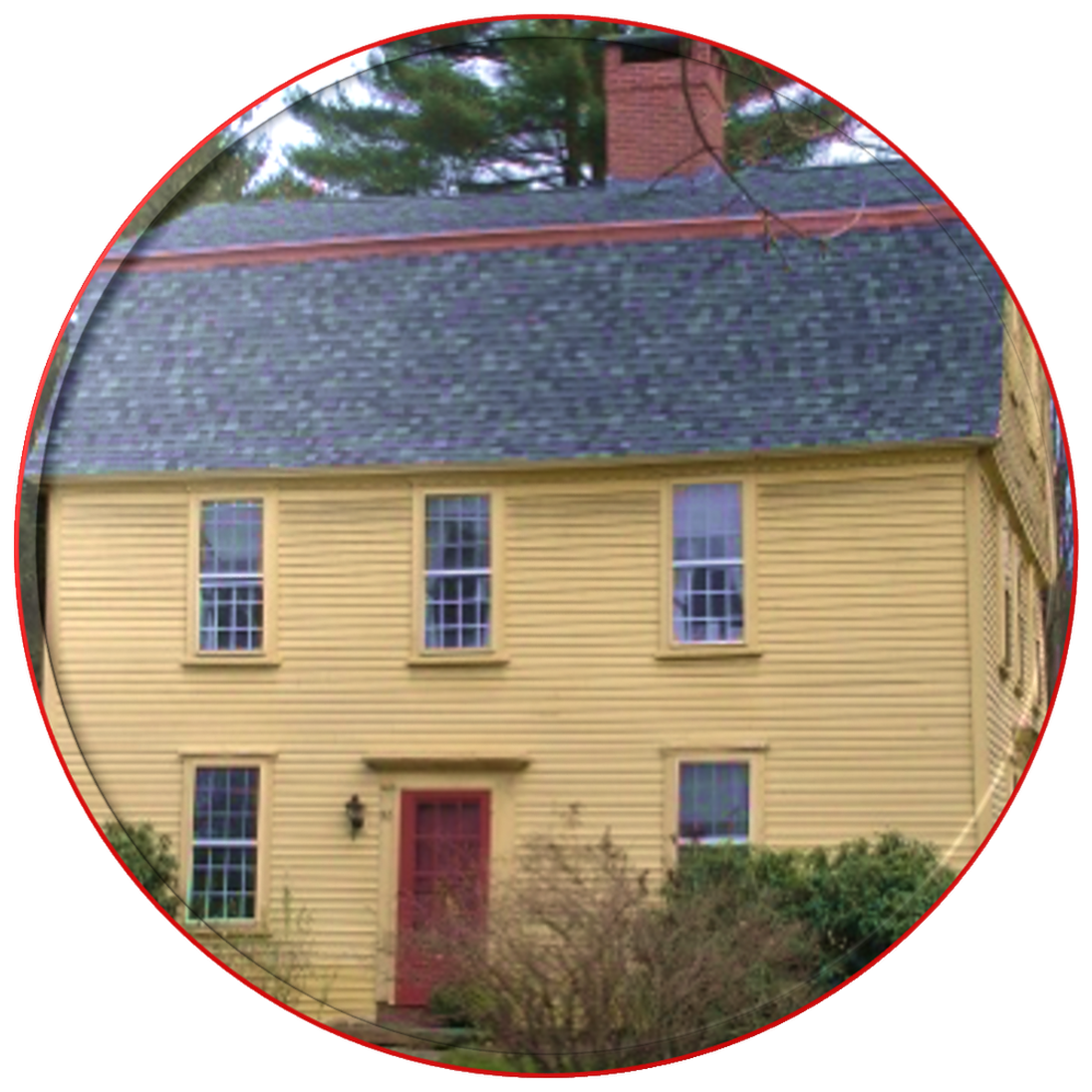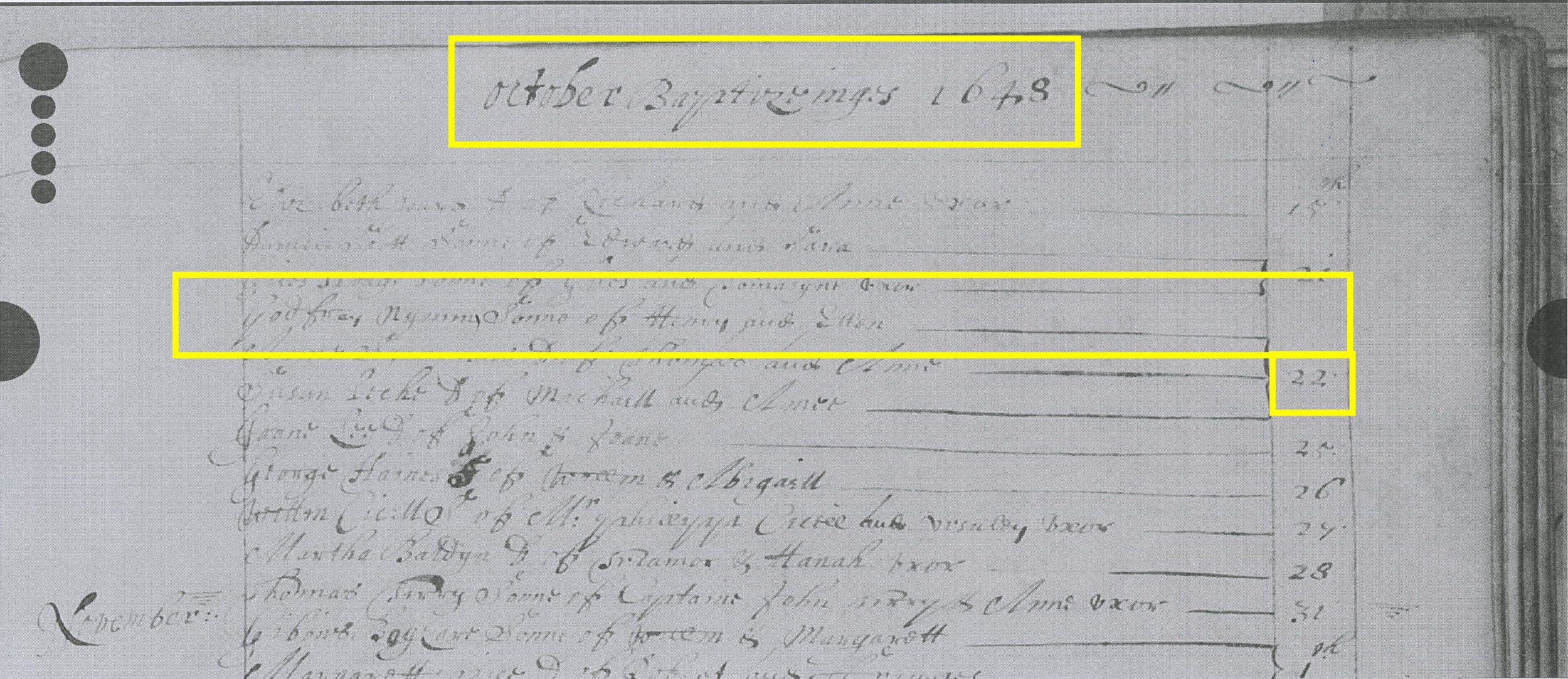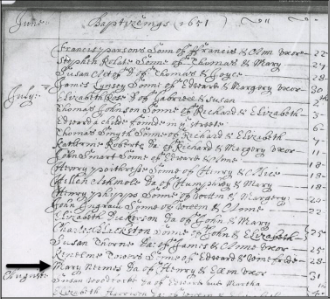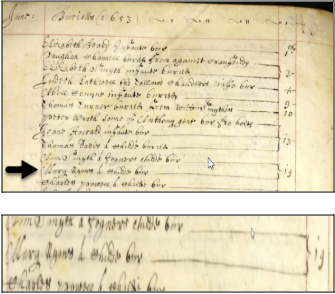Stunning New Data
Rob Brun del Re, P.Eng November 2022
Introduction
And it all started with deciphering one, barely legible, word…
It was the second year of Covid. With little progress made on the quest to uncover when, why and how Godfrey Nims emigrated to New England, I decided to go back to basics: what hard facts did we have about Godfrey and the English Nims family?
Key Documents I had at the time:
A baptismal record for “Godfrey Nymm son of Henry and Ellen” dated 22 October 1648, St Clement-Danes, Westminster, London;
A baptismal record for “Mary Neemes, da of Henry and Ellen uxor” dated 31 July 1651, St Clement-Danes, Westminster
A marriage notice (banns) for “Henry Neemes and Ellinor Denes” dated 28 July 1655, St. Clement-Danes, Westminster.
As ‘Ellinor’ and ‘Ellen’ are found interchangeably in documents of this era, we all assumed that the ‘Ellen’ on Godfrey’s baptismal record and the ‘Ellinor’ of the 1655 marriage banns were the same person. Henry and Ellinor’s marriage occurring several years after the birth of two children was “not at all unusual for the times” in the words of at least one British expert. I accepted that at face value and moved on.
However, the “children-then-marriage” sequence didn’t sit well with me (and others) and it stayed in my craw for years. So, I recently started looking into marriage and family norms in mid-17th century England. The 1655 marriage occurred right in the middle of major civil and religious upheavals in England at that time – the English Civil war had ended in 1651 and Cromwell’s Puritan government, in place at least since the execution of Charles I in 1649, had started enacting laws to delineate the responsibilities of church and state, while imposing its mores on the English public.
That’s when I ran across two key pieces of legislation:
An Act for Suppressing the Detestable Sins of Incest, Adultery and Fornication - known as the “Commonwealth (Adultery) Act” of 1650
An Act Touching Marriages and the Registring thereof; and also touching Births and Burials - known as the “Marriage Act of 1653”
I got a clear impression that fornication was highly frowned upon and being married was a prerequisite to having children. Just to be sure, I tracked down an expert in early English marriage law who graciously confirmed that it would have been highly unusual, especially in Cromwell’s time, for children to be born outside of marriage - the exact opposite of the previous advice.
I decided to go back to the three documents shown at the outset of this article and give them further scrutiny. I noticed a funny (to me) collection of barely legible letters at the end of Mary’s baptismal record. These same letters followed several other entries on the same page - so it must have been an annotation that applied equally to several couples. A couple of hours with a magnifying glass later, I deciphered it as “uxor” … the Latin word for “wife”.
So, in 1651 Ellen was Henry’s wife, yet in 1655 Henry and Ellinor were getting married. Something didn’t add up.
I kicked that around my head for the rest of the day, ending up with the most likely possibility: Henry’s first wife Elinor/Ellen died sometime between Mary’s birth in 1651 and Henry’s second marriage in 1655, coincidentally to another Ellinor (Denes).
So, I tasked a British researcher with another search of St. Clement-Danes’ burials between 1651 and 1655. Sure enough, she found the following:
Burial notice for “Ellen Nyms, wife of Henry” dated 28 December 1654.
Burial notice for “Mary Nyms, a child buried” dated 19 June 1653.
Henery Nemms, gunsmith of Clement-Danes and Eleanor Davis”. It is dated 28 July 1655.
Finding Godfrey Chapter 14
Ellen [Unknown] Nyms, Godfrey’s Mother
Ellinor Denes, as we now know Henry’s second wife, was not Godfrey’s mother. Ellen [Unknown Maiden Name], Henry’s first wife, was Godfrey’s mother.
The fact that Godfrey had lost his own mother and his father remarried may give us a better understanding of why, and perhaps when, Godfrey left England. his mother and little sister were no longer alive and his father remarried in July 1655. Without knowing anything about the relationship with his new step-mother, we can only surmise that this may have been part of the impetus to leave home. And it’s possible that his mother Ellen may have had some connection to Northampton, MA where Godfrey’s presence in America was first recorded. It is now imperative that we try to discover her maiden name and origin. Finding a marriage record for Henry and Ellen would be significant. We haven’t found it yet, but we’re still looking.
At about the same time this was unfolding, a London-based researcher found a second marriage banns, in the neighbouring parish of St. Michael Queenhithe.
The St. Michael’s Banns
The immediate task is determining whether the two couples of St. Clement-Danes and St. Michael Queenhithe are the same people. There are a couple of important issues to consider:
Elinor’s name is quite different in the two records – Denes, Davis
Her home parish is listed as St. Botolph Aldersgate in the Clement-Danes banns; “of this parish” in the St. Michael’s banns; and of St. Botolph without Bishopsgate in Boyd’s Marriage Register (a secondary compilation of marriage registers)
Henry is listed with two different, but possibly complementary occupations
Despite these anomalies the likelihood that the two couples are in fact the same people is very high. If so, we have a significant new layer of complexity to Henry’s life: instead of solely being an inn-keeper from Westminster, he may well have also been a gunsmith.
However, the gunsmith angle opens up a bunch of new research avenues:
Henry Nyms, Gunsmith
Apprenticeship records: We’ve looked at several gunsmith records without success. However, he may actually have apprenticed as a blacksmith or armourer. These apprenticeship records will be investigated imminently
Huguenot connections: Many gunsmiths in England and in London (specifically Clement-Danes parish) were known to have been Huguenots. Despite assurances that Nims is not a Huguenot name and that Henry was most certainly not a Huguenot, the Huguenot angle is back on the table. I’m re-visiting the possibility that Henry apprenticed to a Huguenot tradesman. Perhaps Ellen, Henry’s first wife, was a Huguenot
Armourers: Exploring the relationship between gunsmiths and armourers, especially in times of war and conflict, such as the decades surrounding Godfrey’s birth
Summary
We have ascertained crucial new pieces of information:
Henry Nims was married twice to women with similar names. We need to look at each woman, independently, to see if either had family or connections in Colonial Massachusetts.
Ellen/Elinor Wife #1
Ellen/Elinor Davis/Denes Wife #2
On the St. Michael’s banns, Henery Nemms was listed as a gunsmith. We need to understand the impact this has on our understanding of his background and his family’s connections.
Needless to say, research is proceeding with renewed vigour. I’m more confident than ever that even if we can’t completely solve the riddle of Godfrey’s emigration, we’re going to get awfully close.
A Final Note: The balance of these findings was made with the personal support of President David Nims and the NFA Board, who made research funds available at a crucial juncture in the research. My deepest thanks go to them.
Next Chapter: Chapter 14 - A Remarkable Possibility







